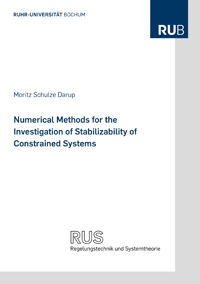
Shop : Details
Shop
Details
48,80 €ISBN 978-3-8440-3904-7Softcover168 pages23 figures249 g21 x 14,8 cmEnglishThesis
September 2015
Moritz Schulze Darup
Numerical Methods for the Investigation of Stabilizability of Constrained Systems
The systematic stabilization of dynamical systems based on a suitable controller is a central task in automatic control. Obviously, this task can only be solved if the underlying system is indeed stabilizable, i.e., if the existence of a stabilizing control law can be guaranteed. For linear unconstrained systems, simple algebraic criteria for the verification of stabilizability are available. In contrast, for nonlinear systems with state and input constraints, such criteria are missing.
The thesis deals with numerical methods for the rigorous investigation of stabilizability of constrained systems. In particular, we present and extend procedures for the computation of stabilizable sets. In this context, the accuracy of the evaluated sets w.r.t. the largest stabilizable set (LSS) is of central interest. To measure accuracy, we rigorously compute inner and outer approximations of the LSS using reachability analysis.
With regard to the initially mentioned task, the identification of stabilizable states only marks the first step towards the stabilization of dynamical systems. Consequently, the second part of the thesis is aimed at the design of stabilizing control laws. Based on the evaluated stabilizable sets, we present efficient model predictive and time-optimal control schemes suitable for nonlinear, bilinear, and linear systems, respectively.
The last part of the thesis concentrates on the exemplary application of the developed methods to some selected systems with practical relevance. Inter alia, we provide control concepts for blood glucose regulation and the operation of a chemical reactor. It is remarkable that, for both applications, we are able to guarantee that at least 97% of all stabilizable states will indeed be stabilized by the designed controllers.
The thesis deals with numerical methods for the rigorous investigation of stabilizability of constrained systems. In particular, we present and extend procedures for the computation of stabilizable sets. In this context, the accuracy of the evaluated sets w.r.t. the largest stabilizable set (LSS) is of central interest. To measure accuracy, we rigorously compute inner and outer approximations of the LSS using reachability analysis.
With regard to the initially mentioned task, the identification of stabilizable states only marks the first step towards the stabilization of dynamical systems. Consequently, the second part of the thesis is aimed at the design of stabilizing control laws. Based on the evaluated stabilizable sets, we present efficient model predictive and time-optimal control schemes suitable for nonlinear, bilinear, and linear systems, respectively.
The last part of the thesis concentrates on the exemplary application of the developed methods to some selected systems with practical relevance. Inter alia, we provide control concepts for blood glucose regulation and the operation of a chemical reactor. It is remarkable that, for both applications, we are able to guarantee that at least 97% of all stabilizable states will indeed be stabilized by the designed controllers.
Keywords: Stabilizability; Constrained Systems; Nonlinear Systems; Predictive Control
Schriftenreihe des Lehrstuhls für Regelungstechnik und Systemtheorie
Edited by Prof. Dr.-Ing. Martin Mönnigmann, Bochum
Available online documents for this title
DOI 10.2370/9783844039047
You need Adobe Reader, to view these files. Here you will find a little help and information for downloading the PDF files.
Please note that the online documents cannot be printed or edited.
Please also see further information at: Help and Information.
Please also see further information at: Help and Information.
| Document |  | Document | ||
| Type |  | |||
| Costs |  | 36,60 € | ||
| Action |  | Purchase in obligation and download the file | ||
| Document |  | Table of contents | ||
| Type |  | |||
| Costs |  | free | ||
| Action |  | Download the file | ||
User settings for registered online customers (online documents)
You can change your address details here and access documents you have already ordered.
User
Not logged in
Export of bibliographic data
Shaker Verlag GmbH
Am Langen Graben 15a
52353 Düren
Germany
Am Langen Graben 15a
52353 Düren
Germany
Mon. - Thurs. 8:00 a.m. to 4:00 p.m.
Fri. 8:00 a.m. to 3:00 p.m.
Fri. 8:00 a.m. to 3:00 p.m.
Contact us. We will be happy to help you.



